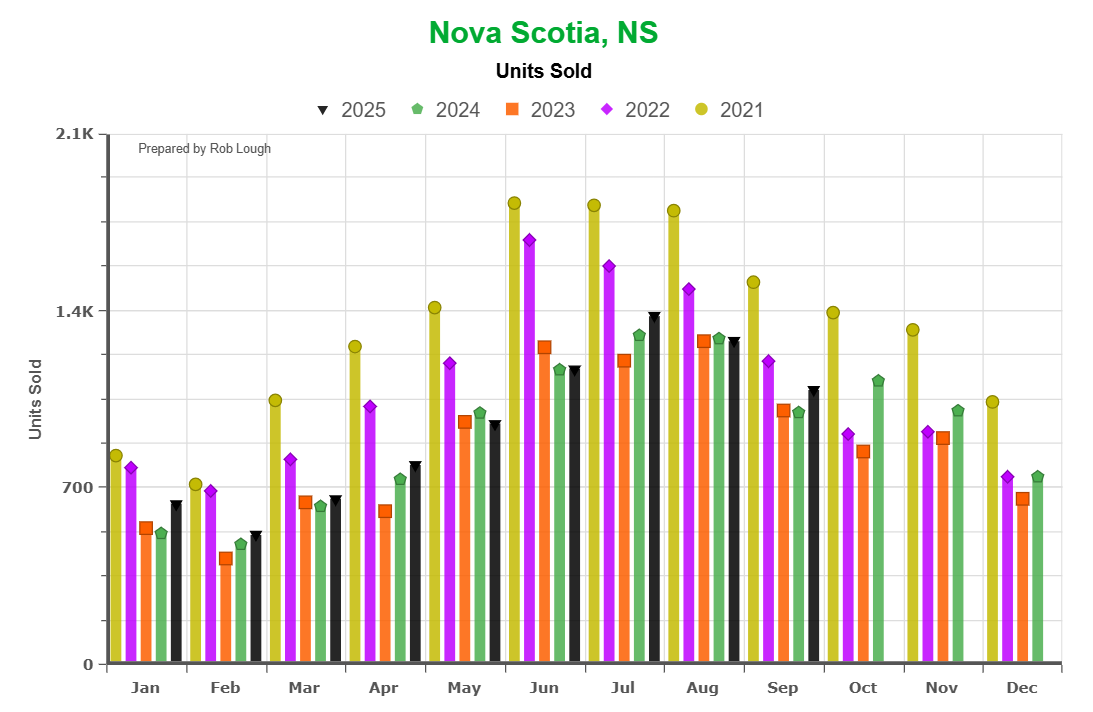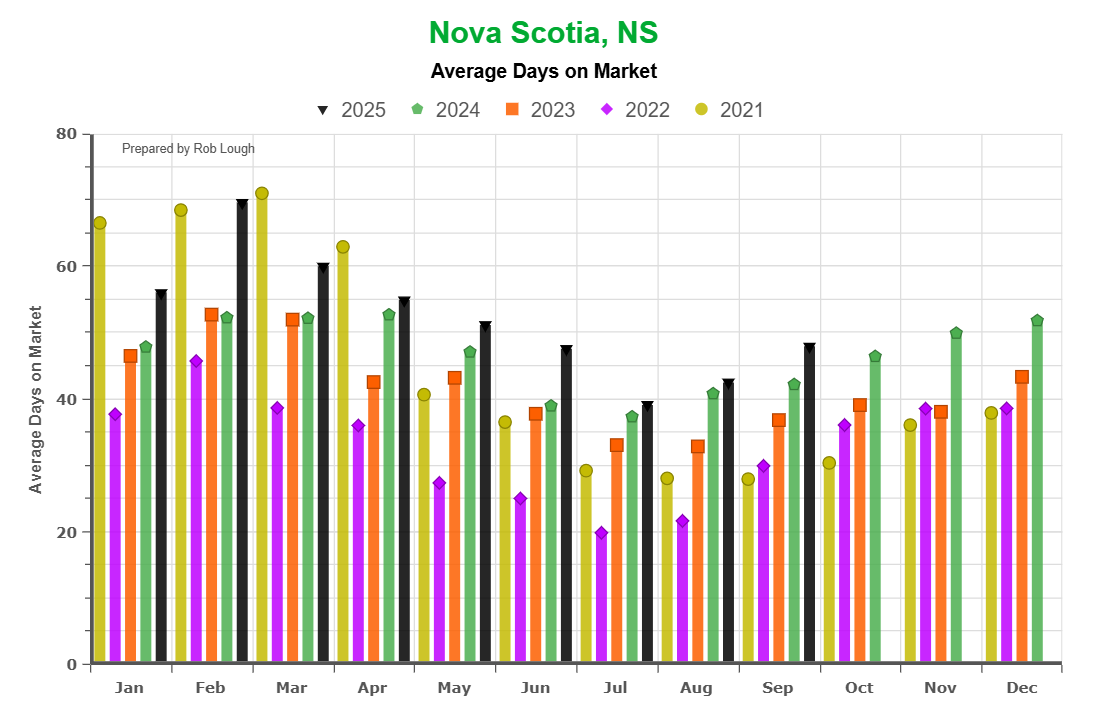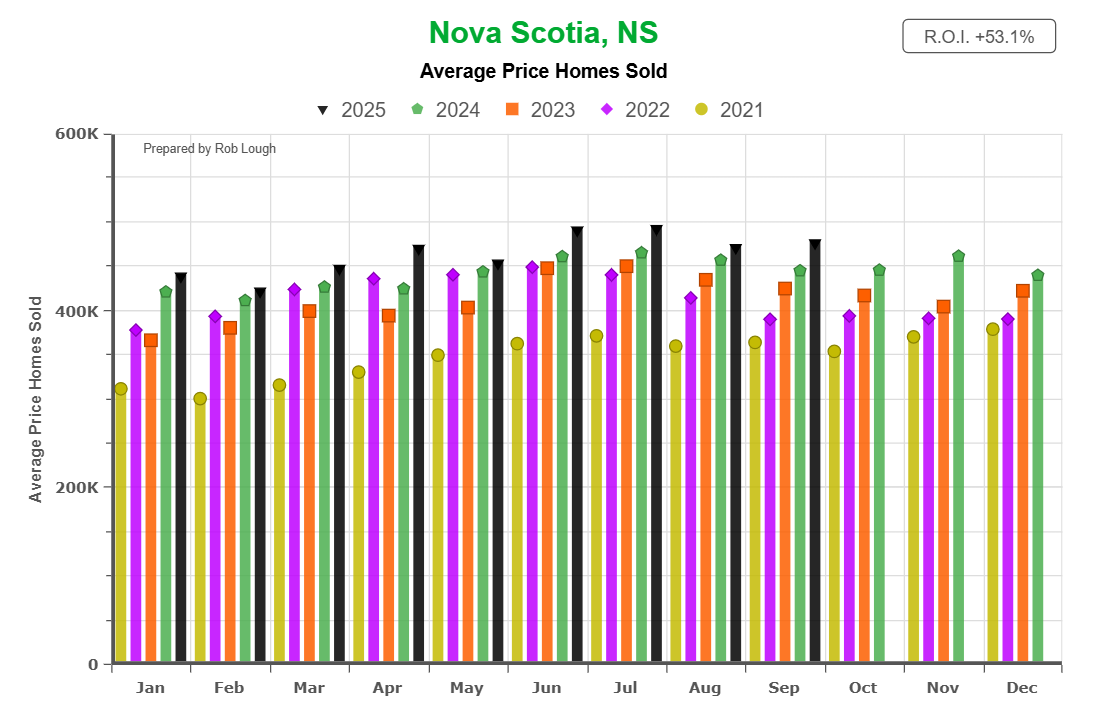Nova Scotia Housing Market 2025: A Comprehensive Analysis of Home Prices and Trends
The Nova Scotia real estate market has experienced remarkable growth over the past five years, with home prices reaching unprecedented levels in 2025. For buyers, sellers, and investors looking to understand the current landscape, this detailed analysis breaks down the key trends, seasonal patterns, market velocity, and what they mean for the future of housing in the province.
Record-Breaking Growth: 53% Return on Investment Since 2021
The Nova Scotia housing market has demonstrated exceptional strength, with average home prices increasing by an impressive 53.1% from 2021 to 2025. This substantial appreciation represents one of the most significant growth periods in the province’s recent real estate history, outpacing many other Canadian markets and reflecting strong demand coupled with limited inventory.
In 2021, the average home price in Nova Scotia hovered around $315,000 to $370,000 depending on the season. Fast forward to 2025, and those same market conditions now see average prices ranging from $440,000 to $500,000—a transformation that has reshaped affordability and market dynamics across the province.
Year-Over-Year Price Trends: Consistent Upward Momentum

Nova Scotia Real Estate Units sold October 2025
2021: The Foundation Year
The 2021 market served as a launching point for Nova Scotia’s explosive growth. With average prices ranging from approximately $315,000 in January to $370,000 during peak summer months, the market was already experiencing increased attention from both local buyers and interprovincial migrants seeking more affordable alternatives to larger Canadian cities.
The 2021 market was characterized by exceptional velocity, with homes selling remarkably quickly. Average days on market ranged from just 28 days in July to approximately 68 days in January and February—representing a seller’s market where properties moved rapidly, particularly during peak season.
2022: Acceleration Begins
By 2022, the market had gained significant momentum. Average prices climbed to the $390,000-$430,000 range throughout the year, representing a substantial year-over-year increase. This period marked the beginning of Nova Scotia’s transition from an affordable market to a competitive one, as word spread about the province’s quality of life and relatively lower costs compared to Ontario and British Columbia.
Market velocity remained extremely strong in 2022, with properties selling even faster than in 2021. Days on market averaged just 20-26 days during summer months, indicating intense buyer competition and multiple-offer scenarios becoming commonplace.
2023: Steady Appreciation
The 2023 market continued the upward trajectory with prices settling in the $400,000-$440,000 range. While growth rates moderated slightly compared to 2022, the consistent appreciation demonstrated the market’s underlying strength and sustained demand. Days on market began to increase modestly compared to 2022, ranging from approximately 33-45 days, suggesting a slight cooling but still indicating a robust seller’s market.
2024: Strong Performance
2024 saw average home prices reach the $430,000-$470,000 range, with summer months pushing toward the higher end of this spectrum. The market remained robust despite broader economic headwinds, including higher interest rates and inflation concerns, proving that Nova Scotia’s appeal remained strong among buyers.
Market velocity in 2024 showed further normalization, with average days on market ranging from approximately 37-53 days throughout the year. While this represented slower movement compared to the frenzied 2021-2022 period, it still indicated healthy market conditions with reasonable absorption rates.
2025: Peak Performance
The current year has brought average home prices to their highest levels yet, ranging from $440,000 in slower months to approximately $500,000 during peak season. July, August, and September 2025 have seen particularly strong performance, with prices consistently at or near the $500,000 mark.
Interestingly, 2025 has seen days on market increase to the 40-56 day range, suggesting buyers are taking more time with purchasing decisions in response to higher price points. However, this still represents a balanced to slight seller’s market, particularly during peak months.
Market Volume Analysis: Understanding Transaction Patterns
The volume of homes sold in Nova Scotia reveals important insights about market activity and seasonal demand patterns that complement the price appreciation story.
Peak Transaction Periods (2021)
The 2021 market experienced extraordinary transaction volumes, with peak months (June, July, August) seeing approximately 1,700-1,800 units sold per month. This represented exceptional market activity as buyers rushed to enter the market before prices climbed higher. Even traditionally slower months like January and April saw 800-1,300 units sold, indicating sustained year-round demand.
Moderating Volumes (2022-2023)
As prices increased, transaction volumes began to moderate. In 2022, peak summer months saw approximately 1,450-1,600 units sold—still robust but notably below 2021 levels. The 2023 market showed further moderation, with summer peaks around 1,250-1,350 units, reflecting the impact of higher prices and interest rates on affordability and buyer capacity.
Recent Patterns (2024-2025)
The 2024 and 2025 markets have shown relatively stable transaction volumes compared to 2023, with monthly sales ranging from approximately 550-750 units in slower winter months to 1,100-1,400 units during peak summer periods. While these figures represent a significant decrease from 2021’s exceptional volumes, they indicate a market finding equilibrium at higher price points.
The stabilization of transaction volumes despite continued price appreciation suggests that the market has absorbed the initial migration surge and is now operating at a sustainable pace with a more balanced mix of local buyers, interprovincial migrants, and investors.
Seasonal Patterns: Summer Peak, Winter Lull
One of the most consistent patterns in the Nova Scotia housing market is the seasonal fluctuation across all metrics—prices, transaction volume, and market velocity.
Summer Months (June-August): Peak Season
The summer months consistently represent the strongest period for the Nova Scotia real estate market across all dimensions:
Prices: July typically sees the highest average prices of the year. In 2025, July prices reached approximately $500,000, representing the annual peak.
Volume: Summer months generate the highest transaction volumes, with June, July, and August accounting for a disproportionate share of annual sales. In 2021’s exceptional market, these months saw 1,700-1,800+ units sold, while even in the more normalized 2025 market, summer volumes reach 1,300-1,400 units.
Market Velocity: Properties sell fastest during summer, with average days on market dropping to their lowest levels. In 2021, homes sold in just 28-30 days during peak season, while even in 2025’s higher-priced environment, summer properties average around 40 days on market.
This pattern reflects increased buyer activity when viewing properties is easier, families prefer to move between school years, and the province’s natural beauty is on full display.
Fall Transition (September-November)
September maintains relatively strong prices and moderate transaction volumes, though both typically soften as autumn progresses. Days on market begin to increase slightly as buyer urgency decreases. This period often sees motivated sellers and serious buyers completing transactions before the holiday season, creating opportunities for negotiations that are less common during peak summer months.
Winter Months (December-February): Seasonal Softening
Winter consistently shows the lowest activity across all metrics:
Prices: January and February show the lowest average prices of the year. In 2025, January prices averaged around $440,000—still historically high but approximately $60,000 below summer peaks.
Volume: Transaction volumes drop significantly, with January and February typically seeing only 550-750 units sold in recent years, less than half of peak summer volumes.
Market Velocity: Homes take longest to sell during winter months. Days on market in January and February 2025 average 50-56 days, compared to approximately 40 days in summer.
This seasonal dip reflects reduced inventory, fewer buyers actively searching during cold weather and holidays, and the general slowdown in real estate activity common across Canadian markets.
Spring Recovery (March-May)
As the weather improves, market activity accelerates across all dimensions. Transaction volumes increase, prices climb steadily toward summer peaks, and days on market decrease as competition intensifies. By May, the market typically approaches or reaches summer activity levels, setting the stage for peak season ahead.
Market Velocity Insights: The Days on Market Story

Nova Scotia Real Estate Days on Market October 2025
The evolution of average days on market tells a compelling story about market dynamics and competition levels over the past five years.
The Ultra-Fast Market (2021-2022)
The 2021 and 2022 markets were characterized by exceptionally fast sales, particularly during peak seasons. Properties selling in 20-30 days were common, with multiple offers driving quick decisions. This velocity indicated intense buyer competition and limited inventory, forcing buyers to act decisively or risk losing their preferred properties.
The Gradual Normalization (2023-2024)
As prices increased and interest rates rose, market velocity began normalizing. Days on market gradually extended to 35-50 day averages, suggesting buyers gained slightly more negotiating power and time to conduct due diligence. This shift represented a healthier market dynamic with less pressure for rushed decisions.
Current Conditions (2025)
The 2025 market shows days on market ranging from approximately 40 days in summer to 55+ days in winter. While this represents slower movement than the 2021-2022 frenzy, it still indicates a reasonably active market. Properties priced correctly and presented well continue to sell within 4-8 weeks, which is considered normal for a balanced market.
The increase in days on market at higher price points is natural and healthy, allowing buyers time to secure appropriate financing, complete inspections, and make informed decisions on significant investments.
Market Implications for Different Stakeholders
For Home Buyers
The current Nova Scotia market presents significant challenges for buyers, particularly first-time purchasers. The 53% price increase since 2021 has substantially impacted affordability, requiring larger down payments and higher mortgage qualifications.
Timing Considerations: Buyers should consider timing their purchase during winter months when competition may be slightly reduced and days on market extend, potentially creating more negotiating leverage. However, they should be prepared for limited inventory during these periods.
Strategic Approach: The increase in average days on market to 40-55 days means buyers have more time to make informed decisions compared to the frenzied 2021-2022 period. Securing mortgage pre-approval, working with experienced local real estate agents, and being prepared to act decisively on suitable properties remain essential strategies.
Market Competition: While transaction volumes have decreased from 2021 peaks, summer months still see 1,300-1,400 units sold, indicating substantial competition. Buyers should expect multiple-offer scenarios on well-priced, desirable properties during peak season.
For Home Sellers
Sellers in Nova Scotia continue to experience favorable conditions with strong demand supporting price growth.
Timing Strategy: Those looking to maximize their sale price should consider listing during late spring or early summer when transaction volumes peak and days on market reach their lowest levels. Properties listed in May-July consistently achieve the highest prices and sell fastest, often with multiple offers.
Realistic Expectations: While the market remains strong, the increase in days on market compared to 2021-2022 means sellers should expect their property to take 5-7 weeks to sell on average, rather than the 3-4 weeks common during the peak frenzy. Pricing competitively from the start remains crucial.
Year-Round Opportunities: Even winter sales are achieving strong prices by historical standards, giving sellers flexibility in timing. However, expect 50+ days on market during December-February and potentially more negotiation on price and terms.
Presentation Matters: With buyers having more time to evaluate properties and compare options, proper staging, competitive pricing, and strategic marketing have become more important. Buyers in this price range are more discerning and have higher expectations for property condition and presentation.
For Real Estate Investors
The consistent year-over-year appreciation makes Nova Scotia an attractive market for real estate investors, but understanding volume and velocity trends is crucial for success.
ROI Analysis: The 53% ROI over four years represents annualized returns that exceed many traditional investment vehicles. However, investors should consider that the most explosive growth period (2021-2022) may not repeat, and future returns may be more modest.
Market Liquidity: The decrease in transaction volumes from 2021’s peaks means investors should account for potentially longer holding periods if quick exits are needed. The market remains liquid, but not at the exceptional pace seen during the initial migration surge.
Entry Timing: With days on market now at 40-55 days versus 20-30 days in 2021-2022, investors have more time to conduct thorough due diligence, analyze comparable sales, and negotiate terms. This represents a healthier environment for making calculated investment decisions.
Strategy Selection: Long-term investors may find opportunities in emerging neighborhoods or properties requiring renovation, capitalizing on the market’s fundamental strength. Those seeking cash flow should carefully analyze rental rates relative to purchase prices and carrying costs, as higher acquisition costs require proportionally higher rents to achieve positive cash flow.
Factors Driving Nova Scotia’s Housing Market Growth
Several interconnected factors have contributed to the remarkable price appreciation and evolving market dynamics:
Interprovincial Migration: Nova Scotia has experienced significant population growth from other Canadian provinces, particularly Ontario and British Columbia, as remote work opportunities have allowed people to relocate from higher-cost markets while maintaining their income levels. The 2021 surge in transaction volumes directly correlates with this migration wave.
Limited Housing Supply: New construction has not kept pace with population growth and demand, creating inventory constraints that support price appreciation. The decrease in transaction volumes from 2021 levels partly reflects supply limitations rather than reduced demand. Development approval processes, labor shortages, and supply chain issues have all contributed to the supply-demand imbalance.
Quality of Life Appeal: Nova Scotia’s natural beauty, cultural amenities, lower cost of living compared to major Canadian cities, and strong sense of community have enhanced its appeal to buyers seeking lifestyle changes. The sustained high summer transaction volumes reflect the province’s appeal to buyers who visit during peak tourism season and decide to relocate.
Economic Development: Investment in local industries, infrastructure improvements, and growing employment opportunities in sectors like technology, healthcare, and professional services have strengthened the economic foundation supporting the housing market.
Market Normalization: The increase in days on market and stabilization of transaction volumes represent a healthy normalization after the exceptional 2021-2022 period, rather than market weakness. This evolution suggests a more sustainable long-term trajectory.
Looking Ahead: What to Expect in Nova Scotia Real Estate
While past performance doesn’t guarantee future results, several factors suggest the Nova Scotia market will remain relatively strong:
Supply-Demand Dynamics: The fundamental supply-demand imbalance is likely to persist in the near term, providing continued support for prices. However, as days on market have increased to 40-55 days, buyers are gaining slightly more negotiating power in a still-competitive environment.
Volume Stabilization: Transaction volumes appear to have found a new equilibrium around 750-1,400 units monthly depending on season, down from 2021’s peaks but sustainable for the market’s current size and composition. This suggests the market has absorbed the initial migration surge and is operating at a pace supported by ongoing demand rather than exceptional circumstances.
Potential Headwinds: Factors that could challenge continued appreciation include affordability constraints limiting the buyer pool, possible economic slowdowns affecting employment and consumer confidence, potential policy interventions designed to cool overheated markets or increase affordable housing supply, and the natural limit of how many buyers can afford $450,000-$500,000 homes.
Market Evolution: Expect more moderate growth rates compared to the explosive 2021-2025 period, with possible stabilization rather than continued rapid appreciation. Days on market may continue to gradually increase as the market finds equilibrium, potentially reaching 50-70 days in normal conditions—still healthy but more balanced than recent years.
Seasonal Predictability: Seasonal patterns across prices, volumes, and market velocity are expected to remain consistent, providing some predictability for buyers and sellers planning their transactions. Summer will continue to dominate activity, winter will remain slower, and spring/fall will serve as transition periods.
Conclusion
The Nova Scotia housing market has undergone a dramatic transformation over the past five years, with average home prices increasing by more than 53%, transaction volumes stabilizing after exceptional 2021 peaks, and market velocity normalizing to healthier levels. This evolution reflects a market that experienced an extraordinary surge and is now finding a more sustainable equilibrium at significantly higher price points.
The data reveals a market that remains fundamentally strong with consistent seasonal patterns, sustained demand supporting prices near $500,000 during peak season, and reasonable transaction velocities that allow buyers time for informed decisions while still moving properties within 4-8 weeks on average.
Understanding these trends across prices, transaction volumes, and market velocity is essential for anyone looking to buy, sell, or invest in Nova Scotia real estate. The market has evolved from the frenzied pace of 2021-2022 to a more balanced environment that still favors sellers but provides buyers with more time and slightly more negotiating leverage than during the peak surge.
Whether you’re a first-time buyer navigating an increasingly competitive market, a seller looking to capitalize on strong demand, or an investor seeking opportunities, staying informed about all dimensions of market performance—not just prices but also volume and velocity—will be key to achieving your real estate goals in this dynamic market.
Data analysis prepared by Rob Lough. Market conditions are subject to change, and prospective buyers and sellers should consult with qualified real estate professionals for personalized advice based on their specific circumstances.

 Facebook
Facebook
 X
X
 Pinterest
Pinterest
 Copy Link
Copy Link

